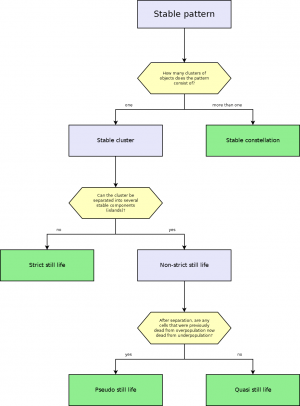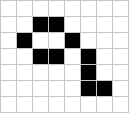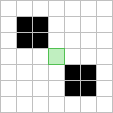Still life
A still life (or stable pattern) is a pattern that does not change from one generation to the next, and thus may be thought of as an oscillator with period 1. Still lifes are sometimes assumed to be finite and non-empty. The two main subgroups of still lifes are strict still lifes and pseudo still lifes. In some contexts, the term "still life" may refer to stable objects rather than stable patterns in general, or strict still lifes rather than stable objects in general.

Strict still lifes
A strict still life is a still life that is either connected (i.e., has only one island), or is such that removing one or more its islands destroys the stability of the pattern. For example, beehive with tail is a strict still life because it is connected, and table on table is a strict still life because neither of the tables are stable by themselves.
 Beehive is a strict still life because it is connected. |
 Beehive with tail is a strict still life because it is connected, even though it contains a smaller still life. |
 Table on table is a strict still life because neither table is stable without the other. |
Pseudo still lifes
A pseudo still life consists of two or more islands which can be partitioned (either individually or as sets) into non-interacting subpatterns which are by themselves each still lifes. Furthermore, there must be at least one dead cell that has more than three alive neighbours in the overall pattern but has less than three alive neighbours in the subpatterns. This final restriction removes patterns such as bakery, blockade and fleet from consideration, as the islands are not "almost touching".
Note that a pattern may have multiple disconnected components and still be a strict (as opposed to pseudo) still life if the disconnected components are dependent on each other for stability (for example, table on table above). Some pseudo still lifes have also been found by Gabriel Nivasch that can be partitioned into a minimum of three and four stable subpatterns, respectively, as in the second and third images below.[1] The stable subpatterns themselves may be either strict or pseudo still lifes. It is not possible to construct a pseudo still life that can be partitioned into a minimum of greater than four stable subpatterns because of the Four Color Theorem.[1]
 The triple pseudo still life, which can be partitioned into three to five independent stable subpatterns, but not two. RLE: here
|
 The quad pseudo still life, which can be partitioned into four still lifes, but not two or three. RLE: here
|
It has been shown that it is possible to determine whether a still life pattern is a strict still life or a pseudo still life in polynomial time by searching for cycles in an associated skew-symmetric graph.[2][3]
Constellations
A (stable) constellation is a still life that is composed of two or more non-interacting objects. This contrasts with pseudo and quasi still lifes, in which the objects in question must interact. Compare for instance the bi-block and blockade:
 Blockade is a constellation because the four blocks do not interact in any way. |
Certain unstable (e.g. oscillating) patterns are sometimes also referred to as constellations. The term "stable constellation" is used to refer specifically to still life constellations.
Quasi still lifes
A stable constellation in which the constituent objects share dead cells, but where all cells that used to remain dead from under-population in the overall pattern still do so in the constituent objects, is called a quasi still life. In Conway's Life, this occurs when objects are diagonally adjacent (e.g. two blocks sharing a single diagonal neighbor), or when single protruding cells in two objects such as tubs share multiple neighbors.
 Two blocks sharing a single diagonal neighbor, marked in green; this cell is dead from underpopulation, and remains so after separation. |
The term "quasi still life" is due to Mark Niemiec.
Enumerating still lifes
The number of strict and pseudo still lifes that exist for a given number of cells has been enumerated up to 34, and the number of quasi still lifes for a given number of cells up to 22.
- The values in the strict still life table below were originally computed by John Conway (4-7 cells), Robert Wainwright (8-10 cells), David Buckingham (11-13 cells), Peter Raynham (14 cells), Mark Niemiec (15-24 cells), Simon Ekström (25-28 cells),[4][5][6] Simon Ekström and "Apple Bottom" (29-30 cells),[7] and Nathaniel Johnston (31-34 cells).[8][9][10][11]
- The values in the pseudo still life table were enumerated by Mark Niemiec (1-24 cells), Simon Ekström (25-28 cells),[4][5][6] Simon Ekström and "Apple Bottom" (29-30 cells),[7] and Nathaniel Johnston (31-34 cells).[8][9][10][11]
- The values in the quasi still life table below were originally computed by Mark Niemiec (8-20 cells) and Simon Ekström (21-22 cells).[12]
| Live cells | Strict still lifes | Pseudo still lifes | Quasi still lifes | ||||||
|---|---|---|---|---|---|---|---|---|---|
| Count ( |
Examples | List | Count ( |
Examples | List | Count | Examples | List | |
| 1 | 0 | 0 | 0 | ||||||
| 2 | 0 | 0 | 0 | ||||||
| 3 | 0 | 0 | 0 | ||||||
| 4 | 2 | block, tub | Full list | 0 | 0 | ||||
| 5 | 1 | boat | Full list | 0 | 0 | ||||
| 6 | 5 | beehive, ship | Full list | 0 | 0 | ||||
| 7 | 4 | eater 1, loaf | Full list | 0 | 0 | ||||
| 8 | 9 | canoe, pond | Full list | 1 | bi-block | Full list | 6 | ||
| 9 | 10 | hat, integral sign | Full list | 1 | block on boat | Full list | 13 | ||
| 10 | 25 | boat-tie, loop | Full list | 7 | bi-boat | Partial list | 57 | ||
| 11 | 46 | elevener | Full list | 16 | 141 | ||||
| 12 | 121 | honeycomb, table on table | Full list | 55 | 465 | ||||
| 13 | 240 | sesquihat | Partial list | 110 | 1,224 | ||||
| 14 | 619 | fourteener, paperclip | Partial list | 279 | 3,956 | ||||
| 15 | 1,353 | moose antlers | Partial list | 620 | 11,599 | ||||
| 16 | 3,286 | bi-cap, scorpion | Partial list | 1,645 | pond on pond | Partial list | 36,538 | ||
| 17 | 7,773 | twin hat | Partial list | 4,067 | 107,415 | ||||
| 18 | 19,044 | dead spark coil | Partial list | 10,843 | 327,250 | ||||
| 19 | 45,759 | eater 2 | Partial list | 27,250 | 972,040 | ||||
| 20 | 112,243 | spiral | Partial list | 70,637 | 2,957,488 | ||||
| 21 | 273,188 | ridiculously long boat | Partial list | 179,011 | 8,879,327 | ||||
| 22 | 672,172 | cis-mirrored worm | Partial list | 462,086 | 26,943,317 | ||||
| 23 | 1,646,147 | ludicrously long boat | Partial list | 1,184,882 | |||||
| 24 | 4,051,732 | lake 2 | Partial list | 3,069,135 | |||||
| 25 | 9,971,377 | very^9 long boat | Partial list | 7,906,676 | |||||
| 26 | 24,619,307 | Mickey Mouse | Partial list | 20,463,274 | |||||
| 27 | 60,823,008 | hat siamese vase | Partial list | 52,816,265 | |||||
| 28 | 150,613,157 | O quad-loaf | Partial list | 136,655,095 | |||||
| 29 | 373,188,952 | xs29_cc0s2ticz330fgkc | Partial list | 353,198,379 | |||||
| 30 | 926,068,847 | Clips | Partial list | 914,075,620 | |||||
| 31 | 2,299,616,637 | Aries betwixt two blocks | Partial list | 2,364,815,358 | |||||
| 32 | 5,716,948,683 | Inflected 30-great sym | Partial list | 6,123,084,116 | triple pseudo still life | Partial list | |||
| 33 | 14,223,867,298 | 15,851,861,075 | |||||||
| 34 | 35,422,864,104 | Partial list | 41,058,173,683 | quad pseudo still life | Partial list | ||||
As the number of bits increases, these counts increase exponentially; the rate for strict still lifes is about O(2.46n), while for pseudo still lifes it is around O(2.56n), and approximately O(3.04n) for quasi still lifes.
See also
- List of common still lifes
- List of pseudo still lifes
- List of still lifes
- List of strict still lifes
References
- Nivasch, Gabriel (July, 2001). "Still lifes". Retrieved on March 23, 2016.
- Cook, Matthew (2003). "Still life theory". New Constructions in Cellular Automata: 93–118, Santa Fe Institute Studies in the Sciences of Complexity, Oxford University Press.
- Cook, Matthew. "Still Life". Mathematical Sciences Research Institute.
- Simon Ekström (January 2, 2017). Re: Enumerating Still Lifes (in C) (discussion thread) at the ConwayLife.com forums
- Simon Ekström (January 3, 2017). Re: Enumerating Still Lifes (in C) (discussion thread) at the ConwayLife.com forums
- Simon Ekström (January 7, 2017). Re: Enumerating Still Lifes (in C) (discussion thread) at the ConwayLife.com forums
- Simon Ekström (January 14, 2017). Re: Enumerating Still Lifes (in C) (discussion thread) at the ConwayLife.com forums
- Nathaniel Johnston (March 27, 2017). Re: Enumerating Still Lifes (in C) (discussion thread) at the ConwayLife.com forums
- Nathaniel Johnston (May 25, 2017). Re: Enumerating Still Lifes (in C) (discussion thread) at the ConwayLife.com forums
- Nathaniel Johnston (April 5, 2019). Re: Enumerating Still Lifes (in C) (discussion thread) at the ConwayLife.com forums
- Nathaniel Johnston (January 9, 2020). Re: Enumerating Still Lifes (in C) (discussion thread) at the ConwayLife.com forums
- Mark Niemiec (January 15, 2017). Re: Enumerating Still Lifes (in C) (discussion thread) at the ConwayLife.com forums
External links
- Still life at Wikipedia
- Still life at the Life Lexicon
- Pseudo still life at the Life Lexicon
- Quasi still life at the Life Lexicon
- Life Object Counts at Mark D. Niemiec's Life Page
